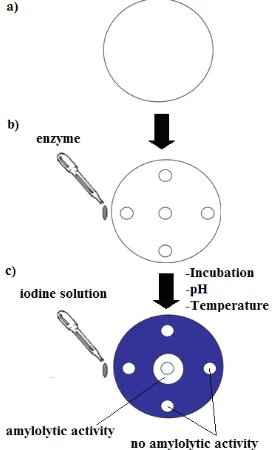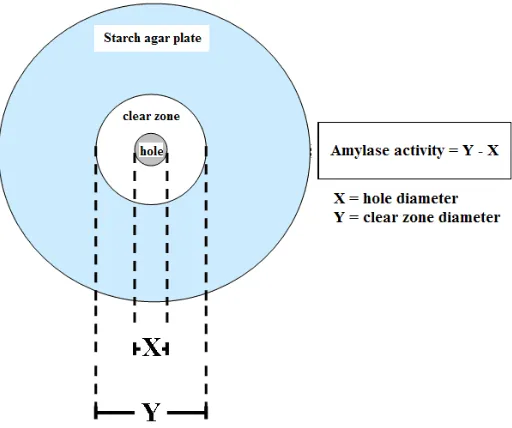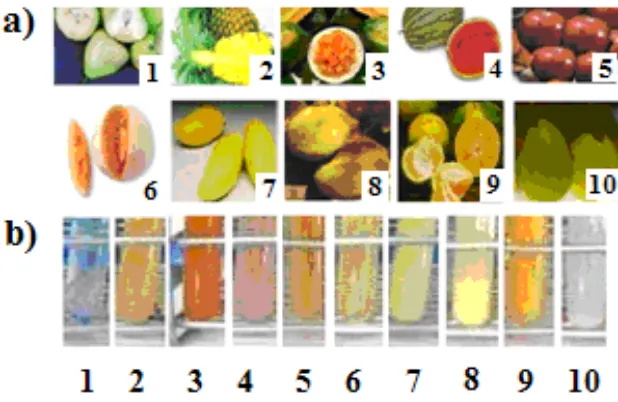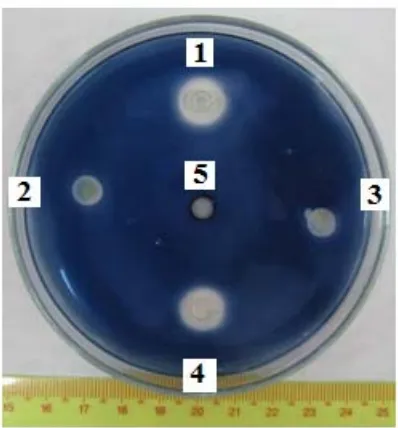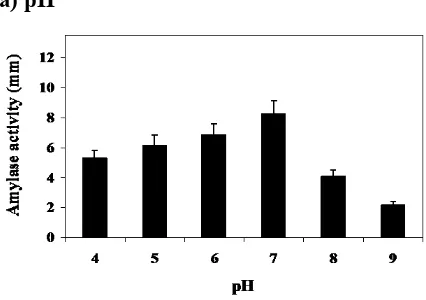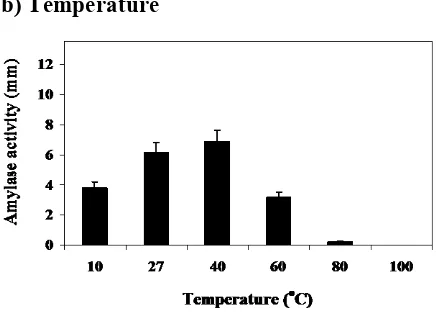As. J. Food Ag-Ind. 2009, 2(03), 402-411
Detection of amylase activity from fruit and vegetables in an
undergraduate classroom
Surasak Laloknam*, Supaporn Sirisopana, Phornphan Attaphinyo, Suwipa Poohuarai and Somkiat Phornphisutthimas
Faculty of Science, Srinakharinwirot University, Wattana, Bangkok 10110, Thailand.
*Author to whom correspondence should be addressed, email: [email protected] [email protected]
This paper was originally presented at the International Conference on the Role of Universities in Hands-On Education, Chiang Mai, Thailand, August 2009.
Abstract
This research aimed to construct a hands-on activity for undergraduate students to understand how to detect and compare amylase activity from various sources by using a simple method. The amylolytic activity of extracts from 10 kinds of vegetables, Chinese white vegetable, tomato, cucumber, pumpkin, pea eggplant, carrot, cabbage, morning glory, Chinese broccoli, and yard long bean as well as 10 kinds of fruit, rose apple, pineapple, papaya, water melon, apple, cantaloupe, mango, jackfruit, orange and pomelo were performed by measuring the size of the clear zone around a hole that contained those extracts on 1% (w/v) starch agar, incubated for 30 min at room temperature and with added iodine solution. The results showed that all samples represented amylolytic activity but that the extracts from pomelo, orange, yard long bean, cabbage, and morning glory showed the 5 highest activities. Students can also use their knowledge to test their samples containing amylolytic activity following the role of pH and temperature. After teaching by this constructivist model, students had gained better understanding, assessed by using 10 open-ended questions as pre- and post-tests. Students were allowed to detect their sample extracts and compare with other student groups after class.
Keywords: education, food science, amylolytic activity, Thailand
Introduction
eukaryotes, because amylase completely catalyzes starch to glucose to use as a primary bio-energy source. These enzymes have considerable application in biotechnology, food, detergents, waste management and pharmaceutical products [1, 2, 3, 4]. In general, amylases are found in various sources, for example, animal (saliva and intestine) and microorganisms (fungi and bacteria) [1, 4, 5].
Amylase has normally been studied from saliva. Generally, these enzymes are used to study properties of enzymes, optimal pH and temperature as well as effects of metal ions. Some people cannot digest proteins and lipids as well as carbohydrates from their food such as meat, oil and sticky rice. The symptoms of this condition are diarrhea, stomach cramps and gas. Combizym, Gaszym, Polyzym and Enzyplex are commercial digestive medicines for patients who have lost some enzyme activity. Besides amylase, these commercial medicines may contain other groups of enzymes e.g. lipase, protease. Most enzymes in medical application are produced from microorganisms, for instance, Aspergillus oryzae; however, there has been a report of allergic reaction after taking medicine from A. oryzae [6].
Figure 1 shows a comparison of the view of constructivist and traditional learning models. Constructivist learning is regarded as being better than traditional learning since the learner can manage the basis of their knowledge with strong patterns [7]. The constructivist learning model is a learning view that shows students can create their new knowledge on the basis of an interaction between prior knowledge and new knowledge that they receive [8]. The constructivism focuses on the learners, the ways people learn, quality experiences and lifelong learning process, rather than on teaching [9]. Laboratory practical learning integrated with constructivist learning can assist students to understand science [10, 11].
Figure 1. Comparison of knowledge retention by constructivist and traditionalteaching methods.
As. J. Food Ag-Ind. 2009, 2(03), 402-411
404
Materials and Methodology
Materials
Rice starch and Agar were purchased from a department store or local markets. Combizym and Saliva were used as a positive control of amylase activity. Conversely, distilled water or buffer was used as a negative control of amylase activity.
Vegetable and fruit samples
One hundred grams of fresh weight from each vegetable; Chinese white vegetable, tomato, cucumber, pumpkin, pea eggplant, carrot, cabbage, morning glory, Chinese broccoli and yard long bean, as well as from each fruit; rose apple, pineapple, papaya, water melon, apple, cantaloupe, mango, jackfruit, orange and pomelo were homogenized with 10 ml of distilled water, filtered by Whatman No.1 paper and stored at 4°C until use. The pH of crude extracts and filtrate from each fruit and vegetable was measured with pH paper.
Detection of amylolytic activity
50 µL of each fruit or vegetable filtrate was added into a 5 mm-hole on starch agar (2.0% agar and 1% starch, pH 7.0) and incubated at room temperature for 30 min. Diameters of the clear zone around the hole were measured when iodine solution was presented (Figure 2). Amylase activity in this research is the value of the diameter of the clear zone surrounding the hole (X) minus the diameter of the hole (Y) (Figure 3).
Optimum pH and optimum temperature
The fruit or vegetable containing the highest amylolytic activity was homogenized with 10 ml of buffer at pH 4 - 9 before loading into the hole of starch agar. Samples were loaded on starch agar at pH 4 - 9 and then incubated at 4, 10, 25, 40, 60 and 80°C, respectively. Diameters of the clear zone around the hole were measured.
Figure 2. Schematic representation for detection of amylolytic activity.
Figure 3. Calculation of amylase activity for this experiment.
Results and Discussion
In this study, twenty kinds of fruit and vegetables were selected for enzyme activity assay. Distilled water was used as a negative control, and Combizym, a medicine containing multi enzymes including lipase, amylase, and protease) and saliva were also used as another positive control. The crude extracts of each sample are shown in Figures 4 and 5.
As. J. Food Ag-Ind. 2009, 2(03), 402-411
406
Figure 5. Preparation of crude extracts. a) Fruit samples and b) crude extracts. 1; rose apple, 2; pineapple, 3; papaya, 4; water melon, 5; apple, 6; cantaloupe, 7; mango, 8; jackfruit, 9; orange and 10; pomelo.
The pH and clear zone diameter of each sample extracted in distilled water was determined. Almost all samples showed acidic pH of 4.0 - 6.0, except for carrot (pH 7.0). The samples were then characterized for amylase activity. The amylolytic activity was detected using the method described above (Figure 3). The reaction can be detected after 30 min, which gives the highest clear zone diameter (data not shown). All samples showed amylolytic activity; the 5 highest activity crude extracts were pomelo, orange, yard long bean, cabbage and morning glory, respectively (Table 1).
Table 1. pH and clear zone diameter of each crude extract from fruit.
Samples pH Average of Clear zone Diameter*
(mm)
Rose apple 5 1.70
Papaya 5 2.80
Cantaloupe 6 1.40
Pine apple 4 2.90
Water melon 5 1.80
Mango 4 1.60
Orange 5 6.90
Pomelo 5 12.00
Jackfruit 5 4.10
Apple 4 3.20
Combizym 6 9.00
Distilled water 6 0.00
Table 2. pH and clear zone diameter of each crude extract from vegetables.
*Data are means from three independent experiments.
Pomelo showed the widest diameter of clear zone, approximately 12.0 mm, compared to distilled water, a negative control. All positive controls, Combizym and saliva showed equal diameter of clear zone, 9.0 mm. Figure 6 shows amylolytic activity from various samples. Pomelo and cabbage showed highest amylase activity for fruit and vegetables, respectively. They were thus selected to study the optimal pH and optimal temperature. The optimal pH and optimal temperature of amylase activity from pomelo were 5 and 27°C, respectively (Figure 7). The optimal pH and optimal temperature of amylase from cabbage were 7 and 40°C, respectively (Figure 8).
Figure 6. Amylolytic activity of some crude extract.
As. J. Food Ag-Ind. 2009, 2(03), 402-411
408
a) pH
b) Temperature
Figure 7. Amylase activity of pomelo crude extract at different pH (a) and temperature (b).
Data are means from three independent experiments with vertical bars representing standard errors of the means.
a) pH
b) Temperature
Figure 8. Amylase activity of cabbage crude extract at different pH (a) and temperature (b).
Data are means from three independent experiments with vertical bars representing standard errors of the means.
Before reinforcing students to learn this concept by a constructivist learning model, students’ prior knowledge was investigated by 10 open-ended questions as a pre-test. Teachers gave the important basic concepts for the laboratory exercise, such as the concept of enzymes, factors affecting enzyme function and rules of general laboratory practice. The subject group was 24 third-year undergraduates and the lab activity was performed in groups (4 students each) to promote cooperative learning. The teachers acted as facilitators to give students some information for constructing the ideas on their own. After the experiment, students were encouraged to discuss the detection and properties of amylase from fruit and vegetables using their plans, and the teacher asked them to make another plan to test the amylase activity from other sources. After class, students were assessed by a post-test. Some of the questions in the pre- and post-tests are given below.
Briefly describe what amylolytic enzymes are.
Explain as best you can, how amylase can catalyze starch. How can you know which fruit have amylolytic activity?
What are the advantages of detection of amylolytic enzyme by starch agar?
The findings showed students had higher post-test scores than pre-test scores. This indicates that students can construct the concepts of amylase and its properties by using their prior knowledge following the constructivist learning model as expected. Moreover, students can make their plans for investigating other sources by using this laboratory model. Not only was learning by the constructivist model better evaluated than the traditional model but also the learner maintained a better attitude and enjoyed the class more than the learner in the traditional model [7].
Conclusion
As. J. Food Ag-Ind. 2009, 2(03), 402-411
410
pharmaceutical products and environmental treatment [15]. At high pH, some industries (e.g. detergent and leather) need tolerant enzymes in alkaline conditions [16]. The amylase activity in some plants (maize and malt) has optimal pH between 4.5 and 6.5 and optimal temperature between 50 and 90oC, respectively [17]. In future work, the purification and characterization of fruit and vegetable producing amylase activity will be investigated.
Even though this technique uses less time to detect amylase activity, it should be very helpful for students for completing other applications in the future such as comparison between the diameter of clear zones and units of enzyme used, or study of inhibitors of amylase activity using this model.
Acknowledgement
The authors express their appreciation to the Faculty of Science, Srinakharinwirot University, for their support and funding to attend the International Conference on the Role of Universities in Hands-On Education, held in Chiang Mai.
References
1. Burhan, A., Nisa, U., Gokhan C., Ashabil, A. and Osmair, G. (2003). Enzymatic properties of a novel thermostable thermophilic alkaline and chelator resistant amylase from an alkaphilic Bacillus sp. Isolate ANT-6. Process Biochemistry, 38: 1397–1403.
2. Shaw, J.F., Lans, F.P., Chen, S.C. and Chen, H.C. (1999). Purification and properties of an extracellular alpha amylase from Thermos sp. Botanical Bulletin of Academia Sinica, 36: 195-299.
3. FAO. (2001). Review: Enzyme Applications for Agro-Processing in Developing
Countries. An Inventory of Current and Potential Application. http://www.fao.org/ag/ags.
4. Carlsen, M. and Neilsen, J. (2001). Influence of carbon source on α-amylase production by Aspergillus oryzae. Applied Microbiology and Biotechnology, 57(3): 346 – 349.
5. Takeuchi, T., Kozu, T., Watanabe, S., Morita, M., Shiratori , K. and Shibata, I. (1978). Substrate specificity for Pancreatic Amylase. Journal of Gastroenterology, 15(3): 395 – 400.
6. Shen, H.D., Lin, W.L., Tam, M.F., Wang, S.R., Tsai, J.J., Chou, H. and Han, S.H. (1998). Alkaline serine proteinase: A major allergen of Aspergillus oryzae and its cross-reactivity with Penicillium citrinum. International Archives of Allergy and Immunology, 116 (1): 29 -35.
7. Lord, T.R. (1997). A comparison between traditional and constructivist teaching in college biology. Innovative Higher Education, 21(3): 197 – 216.
9. DeVries, R. (2002). What is constructivist about constructivist education? Keynote address at the annual meeting of the Association for Constructivist Teaching, Houston, TX.
10. Clough, M.P. (2002). Using the laboratory to enhance student learning. In R.W. Bybee (Ed.), Learning science and the science of learning (pp. 85 - 87). Washington, DC: National Science Teachers Association.
11. Fensham, P.J., Gunstone, R. and White, R. (Eds.). (1994). The content of science: A constructivist approach to its teaching and learning. London: Falmer Press.
12. Laloknam, S., Sirisopana, S. and Phornphisutthimas, S. (2007). A simple detection of protease activity from fruits in undergraduate student. Proceedings of the ICASE Asian Symposium 2007, Pattaya, Thailand, Nov 6 – 9, 2007: CD-ROM.
13. Boonprakobkul, A., Kongwithtaya, S., Chairote, G., Raksajit, W., Laloknam, S. and Thepsawat, S. (2006). Detection of Protease Activity in Fruits. Proceedings of 32nd Congress on Science and Technology of Thailand (STT.32), Bangkok, Thailand, Oct. 10 – 12, 2006: CD-ROM.
14. Kachensuwan, C., Komolkittikan, K. and Laloknam, S. (2008). Detection of lipase
activity from fruits. Proceedings of 34th Congress on Science and Technology of Thailand (STT.32), Bangkok, Thailand, Oct. 31 – Nov. 1 – 2, 2008: CD-ROM.
15. Aiyer, P.V. (2005). Amylases and their applications. African Journal of Biotechnology, 4(13): 1525 – 1529.
16. Sana, B., Ghosh, D., Saha, M. and Mukherjee, J. (2006). Purification and characterization of a salt, solvent, detergent and bleach tolerant protease from a new gamma-Proteobacterium isolated from the marine environment of the Sundarbans. Process Biochemistry, 41 (1): 208 – 215.

